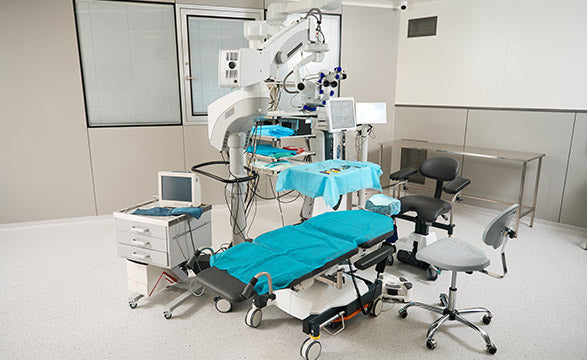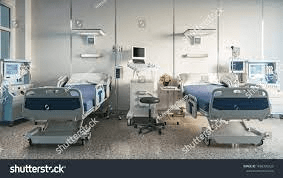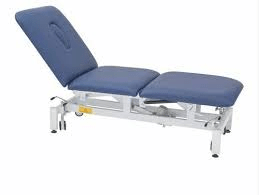When you think of a healthcare setting, what’s the one piece of furniture that comes to mind? While there are many essential components to a medical environment, one piece that often goes unnoticed but plays a pivotal role is the examination couch. Also known as an examination table or medical table, this seemingly simple piece of furniture has evolved over time to become a critical tool in medical diagnostics, treatment, and patient care. In this blog post, we will explore the history, design, and significance of the examination and assemble medical couches in modern healthcare.
A Brief History
The concept of the examination couch dates back centuries, with early records suggesting the use of rudimentary platforms for medical assessments in ancient civilizations. However, it wasn’t until the late 19th century that the examination couch as we know it today began to take shape. Prior to this, patients were often examined while lying in their own beds or on makeshift surfaces.
In the late 1800s, advancements in medical knowledge and technology spurred the need for a dedicated and hygienic space for medical examinations. This led to the development of purpose-built examination couches, which were designed to provide a comfortable and controlled environment ideal for healthcare practitioners to assess patients’ conditions.
Design and Features
The design of the examination couch has evolved significantly over the years to accommodate the changing needs of medical practice. Modern examination couches are meticulously engineered to suit and ensure patient comfort, practitioner convenience, and adherence to stringent hygiene standards. Some key features of contemporary examination couches include:
- Adjustability: Most examination couches are adjustable, allowing healthcare professionals to position the patient in the most suitable way for a thorough examination. Adjustable backrests, leg rests, and height ensure that patients are at the optimal angle for different types of medical assessments.
- Padding and Upholstery: Comfort is a top priority, and examination couches are equipped with cushioned padding and high-quality upholstery. This ensures that patients can lie down comfortably during examinations, often reducing anxiety and discomfort.
- Hygiene and Cleanliness: Infection control is paramount in healthcare settings, and examination couches are designed to be easy to clean and sanitize. Smooth, non-porous surfaces and antimicrobial materials help prevent the spread of pathogens.
- Mobility and Accessibility: Many modern examination couches are equipped with wheels for easy mobility, allowing healthcare professionals to move the couch from one location to another without the need for manual lifting. This is especially crucial in busy medical facilities.
- Accessory Integration: Examination couches often come with various accessories, such as adjustable armrests, paper roll holders, and stirrups, to facilitate a wide range of medical examinations and procedures.
Significance in Healthcare
The examination couch plays a crucial role in various aspects of healthcare:
- Diagnostic Accuracy: Proper patient positioning on the examination couch enables healthcare practitioners to accurately assess and diagnose medical conditions. Whether it’s a routine check-up or a more specialized assessment, the examination couch provides a stable and controlled environment for accurate readings.
- Patient Comfort and Experience: Patients often feel vulnerable and anxious during medical examinations. A comfortable and well-designed examination couch can contribute to a positive patient experience, helping to alleviate anxiety and establish trust between patients and healthcare providers.
- Efficiency and Workflow: In busy medical settings, time efficiency is essential. A well-designed examination couch allows healthcare professionals to conduct examinations smoothly and efficiently, ensuring that patients receive timely care.
- Versatility: Examination couches are used in a wide range of medical specialties, including general medicine, gynecology, orthopedics, and more. Their adaptability and adjustability make them suitable for various medical procedures and examinations.
- Preventive Medicine: Regular medical check-ups are a cornerstone of preventive medicine. Examination couches provide a consistent platform for these routine assessments, contributing to the early detection and management of potential health issues.
First Aid Rooms: An Essential Lifeline in Emergency Situations
First aid rooms, as the name suggests, are spaces specifically designed and equipped to provide immediate care and medical attention in times of emergencies. They can be found in various settings such as schools, offices, factories, stadiums, and large event venues. Their primary function is to offer initial medical relief before professional medical help arrives or the injured or sick individual can be treated or transported to a hospital.
Couches & Accessories
Designed to provide comfort and versatility in medical examination and treatment settings. Explore a wide range of durable and ergonomic medical couches suitable for various medical specialties. Additionally, browse our collection of couch accessories products, including paper roll holders, armrests, and cushions, to enhance patient comfort and optimize clinical procedures. Whether you’re in a clinic, hospital, or private practice, our collection offers the essential tools for creating a functional and patient-friendly environment.
Medical Rooms
Medical rooms, distinct from the common first aid rooms, are designated areas in institutions, work environments, or community centers where comprehensive medical care can be provided beyond just immediate emergency relief. They act as portable miniature clinics or health units, particularly in areas where immediate access to a full-scale medical facility is not feasible.
Significance of Medical Rooms
- Continued Care: While a first aid room serves for immediate relief, a medical room is equipped for extended care, offering services like wound dressing, medication administration, and post-injury observation.
- Diverse Treatments: These rooms can handle a range of medical issues – from basic injuries to chronic disease management.
- Health Monitoring: In establishments like schools or elderly care homes, medical rooms play a role in regular health check-ups and vaccinations.
- Mental Health Support: Modern medical rooms recognize the importance of mental health and often provide space for counseling and psychological support.
Key Features of a Medical Room
- Infrastructure: Medical rooms should be spacious, well-lit, and ventilated. They should have designated areas for patient examination, treatment, and rest.
- Medical Equipment: Apart from basic first aid tools, these rooms should possess medical devices like blood pressure monitors, glucose meters, nebulizers, and more.
- Medication Stock: Essential medications, especially for common ailments like fever, allergies, asthma, or minor infections, should be available.
- Sterilization Area: There should be facilities for sterilizing instruments and equipment.
- Storage: Secure storage for records, medicines, and equipment is essential. For medicines, a cool, dry storage space or refrigerator may be required.
- Communication Tools: It’s crucial to have a phone or an intercom system for communication in case additional help or specialized medical assistance is needed.
- Trained Personnel: Ideally, a medical room should be manned by a trained nurse or medical professional.
- Confidentiality: Given the nature of medical consultations, ensuring patient privacy and confidentiality is of utmost importance.
Assembling a medical couch can be a complex process, as different brands and models may have specific assembly instructions. Below is a general guideline for assembling a basic medical examination couch. Always refer to the manufacturer’s instructions provided with the product or couch, and seek professional assistance if you’re unsure about any steps.
Tools You Might Need:
- Screwdriver (usually Phillips or flat-head, depending on the screws provided)
- Wrench or adjustable spanner
- Hammer
- Gloves (to protect your hands and to keep the couch clean)
Steps to Assemble a Medical Couch:
- Unpack All Components:
- Carefully open the packaging and lay out all components on a clean, flat surface.
- Check the inventory list (usually provided in the assembly manual) to ensure that all parts are present.
- Set Up the Base:
- Identify the base of the couch. This is usually the heaviest component and will provide stability to the couch.
- Some bases come pre-assembled, but if yours isn’t, follow the manufacturer’s instructions to attach any legs or supporting structures.
- Assemble the Backrest and Leg Rest:
- Locate the backrest and leg rest components.
- Attach any supporting bars or hinges that allow these components to move or adjust.
- Ensure that all adjustable mechanisms are functional and secure.
- Attach the Main Couch Surface:
- Position the main surface (where patients will lie) onto the base.
- Securely fasten it using the provided screws or bolts.
- If the couch has adjustable features, make sure they’re functioning correctly before you proceed.
- Install Additional Features:
- Some medical couches come with additional features such as pull-out steps, storage drawers, or attached cabinets. If your couch has these, refer to the manufacturer’s instructions to install them properly.
- Attach Cushioning and Upholstery:
- If the cushioning isn’t pre-installed, place it onto the couch frame.
- Secure any upholstered components, ensuring there are no wrinkles or bubbles. The upholstery should fit snugly to ensure patient comfort and easy cleaning.
- Connect Any Electronic Components:
- If your medical couch has electronic adjustability features, carefully connect any wires or plugs as indicated in the manual. This may involve plugging in motors or controllers.
- Test the electronic features to ensure they operate smoothly.
- Final Inspection:
- Test all adjustable features, including backrest tilt, leg rest elevation, and any electronic components.
- Wipe down the couch with an appropriate disinfectant or cleaner to ensure it’s clean and ready for use.
Safety Tips:
- Ensure you’re working in a spacious area to avoid damaging the couch components or surrounding objects.
- If a step feels overly complicated, don’t hesitate to seek help or consult the manufacturer’s customer service.
- Ensure all screws, bolts, and connections are tightened securely to prevent potential injuries during use.
Once the frame of your medical couch is assembled, it should provide a comfortable and adjustable space for patient examinations and medical procedures. Regularly inspect the couch for wear and tear to ensure safety and durability over time.
An adjustable backrest is a critical feature in various pieces of furniture and equipment, especially in medical settings. Its primary function is to allow the user or patient to achieve a comfortable position by altering the angle of the backrest to suit their needs. This feature is commonly found in medical examination couches, hospital beds, wheelchairs, and even in some modern office chairs.
Benefits of an Adjustable Backrest:
- Comfort: It ensures the patient or user remains comfortable, especially during lengthy procedures or extended periods of sitting or lying down.
- Customization: Catering to individual needs, it allows for a tailored approach to patient care or ergonomic seating.
- Improved Access: For medical professionals, being able to adjust a patient’s position can grant better access to the area they need to examine or treat.
- Postural Support: Helps in maintaining good posture, thus reducing the risk of back pain or strain.
- Recovery: In a hospital setting, an adjustable backrest can aid in the recuperation process, allowing patients to gradually move from a lying to a sitting position.
How to Use an Adjustable Backrest:
- Manual Adjustments: Typically, these involve a lever or knob that, when released, allows the backrest to move freely. Once the desired position is reached, the lever or knob is secured again to lock the backrest in place.
- Electronic Adjustments: Found in more advanced or modern setups, a button or remote is used to control a motor that changes the angle of the backrest. Simply pressing the button in the desired direction will adjust the position.
- Gas Spring Mechanism: Some chairs, especially office chairs, utilize a gas spring to help adjust the backrest angle. By pressing a lever, the user can lean back or forward, adjusting the angle as required, and then release the lever to lock it in place.
Treatment Couch: An Essential Component in Healthcare and Therapeutic Settings
A treatment couch, sometimes referred to as an examination couch or therapy table, is a specialized piece of furniture designed specifically for the medical, therapeutic, and wellness sectors. These couches are used in a wide variety of settings, including hospitals, private clinics, physiotherapy centers, and spa facilities, to name a few.
Conclusion
While often overshadowed by more complex medical equipment, the examination couch holds a significant place in modern healthcare. Its evolution from a simple platform to a versatile, durable, adjustable, and hygienic piece of furniture highlights its importance in medical diagnostics, treatment, and patient care. As healthcare continues to advance, the examination couch will undoubtedly remain a staple in medical environments, supporting the well-being of countless patients and aiding healthcare professionals in delivering accurate diagnoses and effective treatments.


